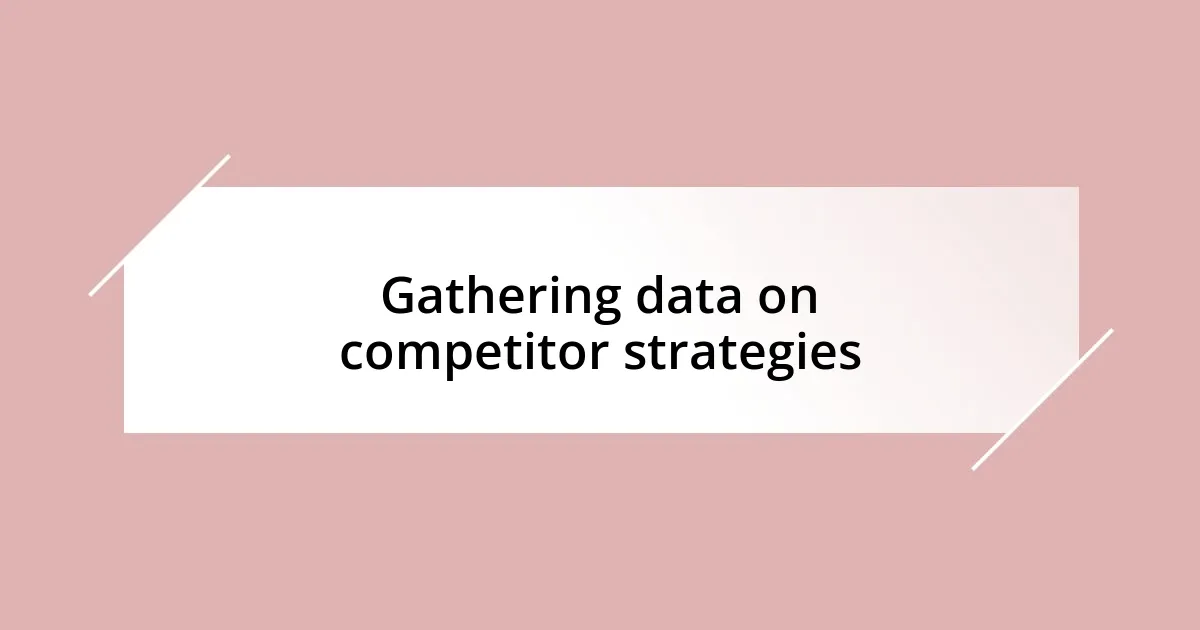Key takeaways:
- Utilize a combination of competitive analysis tools like SEMrush, SimilarWeb, and Google Analytics to gain comprehensive insights into competitors’ strengths and weaknesses.
- Focus on both areas where competitors excel and where they fall short to inform your strategy and seize market opportunities.
- Continuously monitor competitors’ strategies and adapt your own marketing efforts based on observable trends and customer feedback.
- Implement findings from competitive analysis to enhance your offerings and foster deeper relationships with your audience through innovative approaches.

Understanding competitive analysis tools
When I first delved into competitive analysis tools, I felt a mix of excitement and intimidation. It’s quite fascinating how these tools can transform raw data into actionable insights. I remember sitting in front of my computer, exploring platforms like SEMrush and Ahrefs, and thinking, “How do I even make sense of all this?” The sheer volume of information can be daunting, but breaking it down really is the key.
One tool that stood out to me was SimilarWeb, which offers incredible insights not just into website traffic, but also into user behaviors and demographics. I was stunned to discover that I could view a competitor’s audience profile and traction channels all in one place. It made me realize that understanding where my competitors were excelling could directly inform my strategy. Have you ever looked at your industry rivals and wondered where they’re getting it right?
What I’ve learned is that the most effective analysis often requires a blend of multiple tools to capture a comprehensive picture. While one tool might specialize in SEO metrics, another might provide deeper insights into social media performance. I recall combining data from Google Analytics and BuzzSumo, which revealed trends I hadn’t even considered before. It was a game-changer, and it’s this combination that can truly elevate your approach to competitive analysis. What tools have you found useful in your analysis journey?

Analyzing competitors strengths and weaknesses
When I analyze competitors’ strengths and weaknesses, I often take a systematic approach. It’s not just about identifying what they do well; it’s equally important to pinpoint their shortcomings. For instance, I remember examining a competitor who had fantastic user engagement but struggled with customer service. This stark contrast provided me with not only an appreciation of their strengths but also opportunities for my business to shine in areas where they faltered.
Here are a few key aspects to focus on when taking a closer look at competitors:
- Product Quality: Assess the features and benefits of their offerings compared to yours.
- Customer Feedback: Read reviews to gather insights into their strengths and weaknesses from actual users.
- Market Positioning: Evaluate how they present themselves in the market – is it effective?
- Pricing Strategy: Look at their pricing model and determine if it appeals to a broader audience.
- Brand Reputation: Analyze any brand loyalty they may have developed and how you might disrupt that.
Inclusion of such varied factors facilitates a well-rounded understanding, allowing me to craft strategies that leverage not only my insights but also the gaps I see in their operations.

Gathering data on competitor strategies
When it comes to gathering data on competitor strategies, I find that a multi-faceted approach works best. One of my earlier experiences was dissecting the social media tactics used by a rival in my industry. I meticulously documented their posting schedules, the types of content they shared, and the engagement levels. This exercise was enlightening; I realized I could adapt their successful strategies to fit my audience’s preferences without losing my brand’s voice.
Another experience that shaped my perspective was diving deep into my competitors’ email marketing campaigns. I signed up for their newsletters, and each time an email landed in my inbox, I scrutinized the subject lines, offers, and call-to-actions. It was eye-opening to watch how different tactics resonated with audiences. This exercise reinforced the idea that effective strategies often come from observing and understanding what others do, rather than starting from scratch.
Lastly, leveraging tools like SimilarWeb, which I mentioned previously, helped me piece together a more comprehensive view of my competitors’ online footprints. I found that combining organic and paid search data offered insights into where my rivals were allocating resources. This data gathering process often feels like putting together a puzzle; each piece of information contributes to a larger understanding of the competitive landscape. And believe me, seeing that whole picture emerge is incredibly satisfying.
| Competitor | Strategy |
|---|---|
| Competitor A | Social Media Focused |
| Competitor B | Email Campaigns |
| Competitor C | SEO and Content Marketing |

Interpreting competitive analysis results
Interpreting the results of a competitive analysis is more than just comparing numbers; it’s about understanding the narrative behind those figures. When I dive into the data, I often find myself pondering what led competitors to their successes or failures. For instance, after evaluating a competitor’s market plunge, I could see the role their inconsistent branding played. It made me realize that even the slightest misalignment in messaging could impact trust in the marketplace.
I remember a particular moment when I was analyzing customer feedback for a competitor’s product. The sheer volume of negative reviews about an unreliable feature struck a chord with me. It was an emotional experience to see customers expressing their frustrations so candidly. This prompted me to think, “How can I create an offering that genuinely resolves these issues?” From then on, I focused on ensuring that my customer service was not just reactive but proactive, thus turning their pain points into our strengths.
The insights I glean from competitive analysis often serve as a compass for my decision-making. I’ve discovered that interpreting these results requires a good dose of intuition coupled with factual data. For example, by analyzing their pricing strategy, I could gauge not just what price points worked, but also what emotions were at play when customers chose them over a competitor. This strategic interpretation guided me in positioning my offerings to not just meet the market demand but also resonate emotionally with potential buyers. It’s fascinating how numbers can translate to sentiments, isn’t it?

Implementing findings in your strategy
Implementing the findings from your competitive analysis into your strategy can be both thrilling and daunting. I recall a time when I identified a major gap in the content marketing efforts of one key competitor. This realization prompted me to ramp up my blog activities, focusing on topics my audience craved but that my rival neglected. I vividly remember the surge in engagement those posts generated. It made me wonder: how often do we overlook opportunities in our industry by not paying attention to what’s missing?
Adapting and evolving doesn’t just stop after you’ve gathered data; it’s a continuous process. After realizing through competitive analysis that my competitors were leveraging user-generated content effectively, I put a plan in motion to encourage my own audience to share their experiences with my brand. I rolled out a campaign that highlighted customer stories, and the emotional connection it created was palpable. If I hadn’t actively examined their strategies, I might have stuck to my old ways, missing out on building a richer relationship with my audience.
When it comes to implementing findings, it’s crucial to remain flexible. I remember launching a new product after tweaking my marketing strategy based on competitor insights. I had analyzed their launch strategies closely and decided to take a slightly different approach by engaging directly with potential customers beforehand. The feedback I received shaped the final product in ways I hadn’t anticipated, demonstrating that while analysis is vital, being adaptable to feedback can lead to even greater successes. Have you ever adapted your approach based on real-time insights? It can lead to some amazing breakthroughs!

Monitoring competitors for ongoing insights
Keeping a close eye on competitors can feel like peering through a telescope into a distant world of opportunities. I recall a time when a rival’s social media campaign caught my attention—by analyzing their post engagement and audience response, I discovered they were tapping into a community I hadn’t considered. This revelation ignited a spark within me to engage more deeply with niche audiences, leading to collaborations that transformed my brand’s presence.
It’s not just about noting competitors’ successes; it’s crucial to dissect their challenges as well. I remember when a competitor faced backlash over a product recall. The wave of negative sentiment that followed was palpable. It made me acutely aware of the importance of transparent communication with my customers. I couldn’t help but think, “How can I ensure my audience knows we’re here for them, especially when challenges arise?” This situation reinforced my commitment to customer trust through open dialogue.
Finding ongoing insights through competitor monitoring isn’t just a task; it’s a journey of continuous learning. I often find myself asking, “What can I learn today?” I regularly revisit competitor benchmarks and track shifts in their strategies, leading to surprising connections that may have gone unnoticed before. It’s fascinating how each analysis can lead to a new idea or approach you hadn’t considered, fueling creativity and innovation in my own practices!














